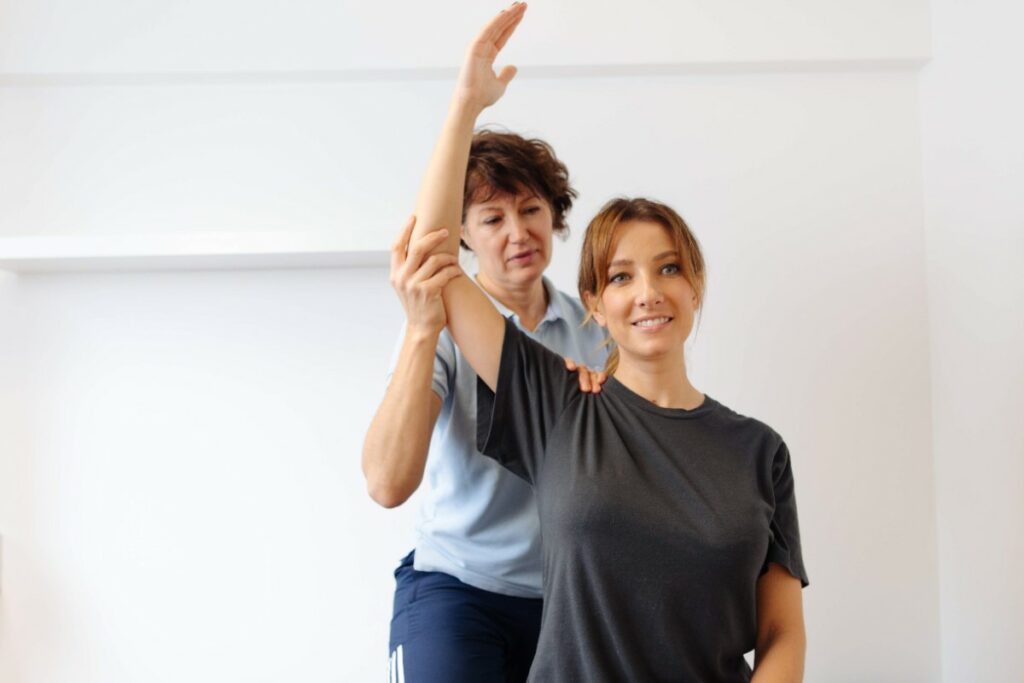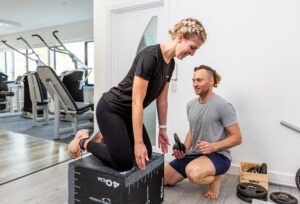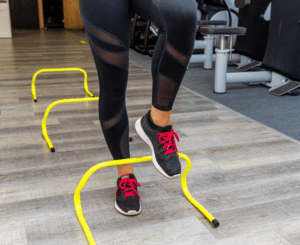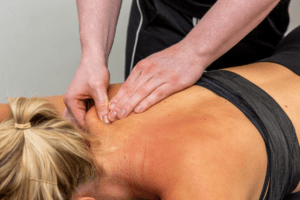At tops:health, one of the more frequent issues we assess in our clinics is shoulder pain when reaching an arm or both arms overhead. This nagging pain is typically felt over your shoulder joint and aggravated by movements such as a shoulder press in the gym, reaching in to a high kitchen cabinet or pruning that pesky rose bush that’s just out of reach.
Below we have identified four key areas that each could be contributing to your shoulder pain and we can show you safe ways to address these issues.
- Rounded shoulders
To achieve full overhead range of movement we require our glenohumeral (shoulder) joint to have adequate movement into lateral rotation to prevent an anatomical block within our joint. You can test this for yourself, if you try to move you arm straight out to the side with your thumb facing downwards, which is placing our shoulder in medial rotation then you will not have full movement. However, as soon as you twist your thumb towards the ceiling, placing our shoulder in lateral rotation, you should be able to move your arm freely above your head. If you have protracted or rounded shoulders then our shoulder will sit forwards into medial rotation, meaning we will most probably be hitting some of those anatomical blocks when reaching overhead.
A great exercise to counteract this is to stretch the muscles in your chest and armpit (pectorals and subscapularis). To perform this stretch, lay flat on your back with a rolled up towel running lengthways up your spine and both knees bent up/ feet flat on the floor. Take both arms out to the side, bend your elbows at 90 degrees and try to rest you hands on the floor. You may already feel a stretch in this position but if you don’t then allow both knees to roll to one side, this should provide a stretch to the opposite chest/ shoulder. Hold this position for 30 seconds. Repeat twice each side. Try to do this daily, ideally up to 3 times/ day.
- Weak rotator cuff
The rotator cuff is the combination of deep lying tendons surrounding your glenohumeral joint that provide the shoulder with stability and strength. Weakness to this group of tendons especially the posterior rotator cuff (back of the shoulder), which produces lateral rotation of the shoulder, can prevent our shoulder moving freely overhead. This weakness can develop over time if you have rounded shoulders or spend time with your arms protracted in front of you, for example at a computer. A great strengthening exercise to your posterior rotator cuff/ lateral rotators involves a theraband and a wall. Have your forearms placed against the wall in front of you, your hands should be shoulder width apart and more importantly your elbows should be shoulder width apart, meaning both forearms are parallel. Have a small amount of tension in the band to start with, slide both arms apart keeping contact with the wall and keeping both forearms parallel. Go as far as you can manage without moving your body towards the wall. To start with repeat this 20 times which should cause the shoulder to fatigue, if it doesn’t then you may want to invest in a stronger theraband or repeat it more times. Repeat this twice with a 60s rest. Do only once/ day.
- Latissimus dorsi tightness
The latissimus dorsi is a large broad sheet muscle that attaches from our upper arm by our armpit and travels all the way down to our pelvis, it’s action is to bring our arm back down to your side when your arm is above your head. It’s most noticeable/ defined in swimmers as breaststroke/ butterfly stroke build this muscle. When this muscle gets tight, which can happen with lots of swimming, rowing, rock climbing, pull ups or even walking with elbow crutches then this restricts how much our arm can move above our head. A nice stretch for this muscle is performed on all fours, place one hand on the floor above your opposite hand, resting on your little finger. Keep this hand placed firmly on the floor and take your bottom backwards towards your heels, you should feel a stretch in the back of your arm down to your ribs on that side. Hold this position for 30 seconds. Repeat twice each side. Try to do this daily, ideally up to 3 times/ day
- Thoracic spine stiffness
The thoracic spine is the middle part of your spine between your neck and lower back, having mobility in your thoracic spine is integral to having good shoulder health. A rounded mid back otherwise known as a thoracic kyphosis can lead to our shoulders protracting forwards. This will then lead to our shoulders rolling forwards into medial rotation, this will result in difficulty moving our arms overhead as we know from before, our shoulder needs to have adequate lateral rotation to achieve good overhead range of movement and stop hitting into those anatomical blocks. A good thoracic extension exercise is performed by kneeling in front of a chair, cupping your hands together and placing both elbows on its surface. Keeping your bottom back towards your heels, try to lower your mid back down towards the floor, place you head on the edge of the seat to take the weight of your head off. Hold this position for 30 seconds. Repeat twice each side. Try to do this daily, ideally up to 3 times/ day.
Hopefully this will provide relief if you’re having issues with overhead reaching, however if this doesn’t help or you’re having problems with these exercises then please don’t hesitate to contact us to book in for an initial assessment for one of our great physiotherapists to take a closer look.



